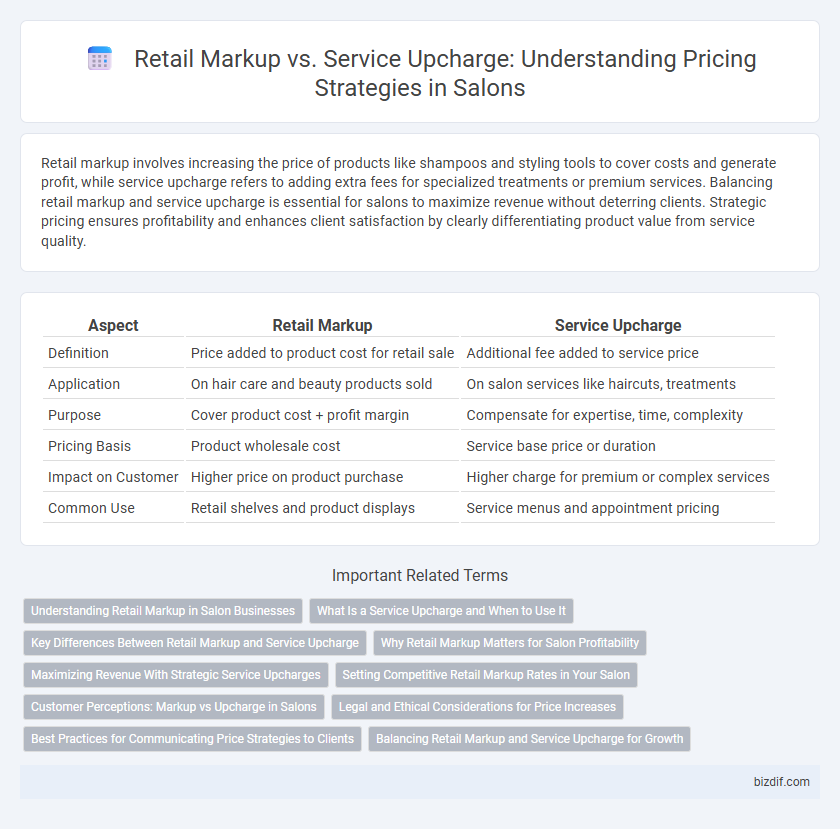Retail markup involves increasing the price of products like shampoos and styling tools to cover costs and generate profit, while service upcharge refers to adding extra fees for specialized treatments or premium services. Balancing retail markup and service upcharge is essential for salons to maximize revenue without deterring clients. Strategic pricing ensures profitability and enhances client satisfaction by clearly differentiating product value from service quality.
Table of Comparison
| Aspect | Retail Markup | Service Upcharge |
|---|---|---|
| Definition | Price added to product cost for retail sale | Additional fee added to service price |
| Application | On hair care and beauty products sold | On salon services like haircuts, treatments |
| Purpose | Cover product cost + profit margin | Compensate for expertise, time, complexity |
| Pricing Basis | Product wholesale cost | Service base price or duration |
| Impact on Customer | Higher price on product purchase | Higher charge for premium or complex services |
| Common Use | Retail shelves and product displays | Service menus and appointment pricing |
Understanding Retail Markup in Salon Businesses
Retail markup in salon businesses involves increasing the cost of hair care products and cosmetics above their wholesale price to generate profit, typically ranging from 30% to 100%. This pricing strategy helps salons cover overhead costs while providing clients with premium haircare brands. Understanding retail markup is crucial for salon owners to balance competitive pricing and profitability without compromising client satisfaction.
What Is a Service Upcharge and When to Use It
A service upcharge in a salon refers to an additional fee added to specific services to cover extra costs or specialized labor, often applied for premium treatments or last-minute bookings. It is used strategically to balance operational expenses without inflating overall retail prices on products. Salons implement service upcharges to maintain profitability while offering high-quality, customized client experiences.
Key Differences Between Retail Markup and Service Upcharge
Retail markup in salons refers to the percentage added to the wholesale price of products sold to customers, typically ranging from 30% to 100%, ensuring profit on retail items like shampoos and styling tools. Service upcharge involves an extra fee applied to specific services such as hair coloring or extensions, often used to cover additional time, materials, or expertise, enhancing overall service profitability. The primary difference lies in retail markup targeting physical product sales while service upcharge addresses labor and expertise costs during service delivery.
Why Retail Markup Matters for Salon Profitability
Retail markup directly impacts salon profitability by increasing the margin on product sales, which often carry higher profit percentages than service fees. Most salons achieve better overall income by strategically pricing retail items like shampoos and styling products, considering wholesale cost and market demand. Effective retail markup enables salons to offset lower service margins and boosts revenue stability even during fluctuating appointment volumes.
Maximizing Revenue With Strategic Service Upcharges
Strategic service upcharges in a salon setting optimize revenue by aligning pricing with customer preferences and service value, often resulting in higher profit margins than standard retail markup. Implementing tiered service upcharges based on product quality or customization encourages clients to choose premium options, leveraging perceived value and increasing overall transaction size. Data-driven decisions on upcharge rates combined with targeted communication enhance client satisfaction and boost salon profitability.
Setting Competitive Retail Markup Rates in Your Salon
Setting competitive retail markup rates in your salon requires analyzing industry standards, product costs, and target profit margins to ensure profitability without deterring customers. Typical salon retail markups range between 50% to 100%, reflecting the balance between cost recovery and competitive pricing. Understanding customer demand and competitor pricing helps tailor markup strategies that maximize revenue while maintaining client loyalty.
Customer Perceptions: Markup vs Upcharge in Salons
Customers often perceive retail markup in salons as a standard practice for product sales, while service upcharges can trigger sensitivity due to their direct impact on pricing transparency. Retail markups are generally accepted when associated with professional advice and exclusive products, enhancing perceived value. Service upcharges, however, may lead to dissatisfaction if not clearly communicated, as clients expect consistent pricing for salon services.
Legal and Ethical Considerations for Price Increases
Salon owners must navigate legal regulations that vary by jurisdiction when applying retail markups or service upcharges to avoid deceptive pricing practices and ensure compliance with consumer protection laws. Ethically, transparent communication about price increases fosters customer trust and helps prevent disputes related to unexpected charges on retail products or salon services. Adhering to established industry standards and clearly disclosing markup policies aligns with both legal requirements and ethical expectations in the salon business.
Best Practices for Communicating Price Strategies to Clients
Clearly explaining retail markup and service upcharge enhances client trust and transparency in salon pricing strategies. Use straightforward language to differentiate product costs from service fees, emphasizing the value clients receive from professional expertise and quality products. Consistently provide detailed receipts and offer pre-service consultations to ensure clients understand pricing before treatment, reducing confusion and improving satisfaction.
Balancing Retail Markup and Service Upcharge for Growth
Balancing retail markup and service upcharge is essential for salon profitability and sustainable growth, with retail markup typically ranging from 50% to 70% to cover product costs and overhead. Service upcharges, often set between 10% and 25%, reflect the expertise, time, and ambiance offered, enhancing perceived value. Optimizing both pricing strategies ensures competitive positioning while maximizing revenue per client visit in the salon industry.
Retail Markup vs Service Upcharge Infographic

 bizdif.com
bizdif.com